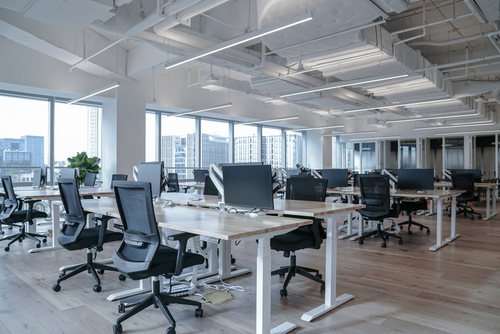Gallup measures employee engagement by surveying samples of the working population on various workplace issues, like profitability, productivity, customer service, and retention, linked to business outcomes. According to a recent Gallup poll, only 32% of U.S. employees overall were engaged in 2022.

With the influx of new generations of professionals with different working styles, smart business leaders and facility executives know that it’s not just the right combination of talented employees that makes an office experience come together, but the physical office itself. Turning the office into a desirable destination is even more important for companies mandating return-to-office policies.
The “smaller but smarter” workspace was a growing trend in 2023 as many organizations reduced their real estate footprints. This will likely continue as findings from a recent CBRE survey state more than half (53%) of companies expect their office portfolios to get smaller over the next three years.
At the same time, facility executives realize the importance of making the physical office more attractive and productive for employees. Global real estate consultants Knight Frank uncovered the important role of real estate in fighting the war for talent. In a recent Knight Frank report, a large percentage of respondents expected to increase the quality of occupied space across their portfolios over the next three years.
It’s no surprise that technology, once again, is key in maximizing traditional office space and maintaining employee engagement, when they’re working in smaller spaces—oftentimes without assigned desks or offices.
Long-term success and maximum productivity require a seamless experience for employees to collaborate and communicate as efficiently as possible—regardless of where they are working. Facility executives can play a key role in optimizing workspaces to meet employee needs and maintain high productivity and engagement. And employee expectations are higher than ever.
While we may be almost three years removed from the Great Resignation, employees still want more than just a paycheck. They want to be engaged in their work, have a good workplace experience, and feel supported by their employers.
So how do companies reduce their physical space, while making the traditional office more enticing, engaging, and productive?
Do More With Less Space
An in-office environment is still essential for employees. In the JLL Future of Work Survey 2022, 72% of respondents agreed the office will continue to be a central part of an organization’s ecosystem.
Facility executives must realize their office space decisions significantly impact employees’ work lives. Smarter and more efficient workspaces can dramatically affect employee engagement, as well as productivity and well-being. So how do you do more with less?
Besides eliminating cubicles and adopting a more open design, there are a few digital tools facility executives can add to traditional workspaces to improve productivity and engagement.
Space Reservation Software
A common challenge employees face in the office is booking the right meeting rooms, desks, workstations, and other workplace resources. Many companies are opting against permanent, assigned desk spaces for employees and instead encouraging hoteling, where staff members choose and reserve desk space when working in the office. However, more than a quarter of organizations haven’t adopted any new technology that supports employees returning to the workplace.
To make the most out of your flexible workspace arrangement, a space reservation system allows employees to easily find and book available rooms and workstations best suited for them on the days they plan to be in the office.
When redesigning your facility, consider how you integrate desk amenities throughout various offices. Think about what kinds of desks and amenities employees need to be productive. Some employees prefer standing desks, while others might want a corner desk with dual monitors.
Digital Signage
Digital signage is becoming an increasingly popular method of communicating with employees within the office environment. It allows messages to be displayed more often, and businesses can choose when and where to display their messages, increasing message saturation. Digital wayfinding signage provides directions, delivers important announcements, and can be updated immediately when changes occur, providing a better visitor experience.
With digital signage, both employees and visitors have a more engaging and efficient experience.
Visitor and Employee Management Tools
Appspace’s 2023 Workplace Trends and Insights Research revealed half of the survey respondents were unsure if someone they encountered at the office worked for their company or was authorized to be on site. To effectively help employees feel secure, you first need to know who’s coming into your facilities and how often. Visitor and employee management tools can help facilities leaders ensure full control and visibility of everyone in and out of their sites. Knowing what to expect in office buildings can keep people safe, prevent overcrowding, and remove any bottlenecks from the sign-in process.
A digital visitor management system can also eliminate the need for formal receptionists, especially in open floor plan offices, flex workspaces, and other informal working locations. Self-service touchscreen kiosks create a smooth experience and speed up the check-in process. With visitor management systems in place, visitors will have a better first impression of the facility and can get down to business faster.
How Modern Workplaces Will Win
Great workplaces aren’t formed by accident. And, neither are great facilities. The modern-day office environment has undergone a massive transformation. Spaces are smaller, but they also are more innovative and efficient. Engaged employees lead to productive business outcomes, and investing in your facilities and creating smarter, but smaller, workplaces also can improve your bottom line.
Scott Chao is chief growth officer at Appspace, which provides a unified workplace communications and workplace management platform to facility leaders at global companies. Before Appspace, Chao held leadership positions at DealerSocket, Stack Sports, and Cvent. He has an MBA from the University of Texas, Austin and dual degrees from Duke University.
